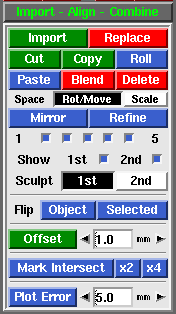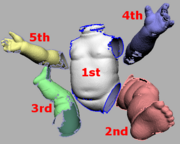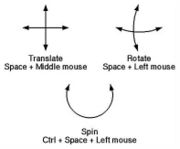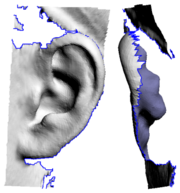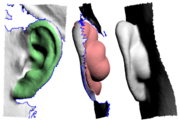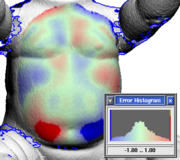PlyEdit: Import Align Combine
From Headus Docs
| Revision as of 02:12, 11 December 2010 (edit) Headus (Talk | contribs) ← Previous diff |
Current revision (06:44, 16 December 2010) (edit) (undo) Headus (Talk | contribs) |
||
| (18 intermediate revisions not shown.) | |||
| Line 25: | Line 25: | ||
| ; Refine : If you need to align two meshes together that are the same shape, then the '''Refine''' tool can be used to calculate a closer fit than you could ever get my manually positioning them. You still need to roughly position them over the top of each other with {{key|Space}}, but once that's done, just click '''Refine'''. The 2nd "red" mesh is then rotated and moved around in gradually smaller amounts to get the best fit between itself and the first "white" mesh. | ; Refine : If you need to align two meshes together that are the same shape, then the '''Refine''' tool can be used to calculate a closer fit than you could ever get my manually positioning them. You still need to roughly position them over the top of each other with {{key|Space}}, but once that's done, just click '''Refine'''. The 2nd "red" mesh is then rotated and moved around in gradually smaller amounts to get the best fit between itself and the first "white" mesh. | ||
| - | : The five toggle boxes underneath (numbered 1 to 5) represent the 5 stages of refinement, where 1 is the coarsest, and 5 is the most fine. The first stage is designed to be quick and dirty, pulling meshes closer together that are far apart, but sometimes this stage actually moves meshes out of alignment; this is especially a problem when there's not a lot of overlap between the two meshes. If yhis happens, turn off number 1 and maybe number 2, | + | : The five toggle boxes underneath (numbered 1 to 5) represent the 5 stages of refinement, where 1 is the coarsest, and 5 is the most fine. The first stage is designed to be quick and dirty, pulling meshes closer together that are far apart, but sometimes this stage actually moves meshes out of alignment; this is especially a problem when there's not a lot of overlap between the two meshes. If this happens, turn off number 1 and re-run the refine. You can turn the other stages of refinement on and off for finer control over the process. |
| - | ; Show : | + | ; Show : Tick either of the boxes to show or hide the first or second meshes. You can also use the {{key|1}} or {{key|2}} hotkeys to toggle each mesh on and off. |
| - | ; Sculpt : | + | ; Sculpt : Select which mesh is affected by the sculpting brushes. |
| - | ; Offset : | + | ; Flip : Inverts the surface normals on either the 2nd "red" mesh, or the green selected faces on the first "white" mesh. |
| - | ; Flip : | + | == Offset == |
| + | |||
| + | {{img|PlyEdit-ear1.png|Missing Behind Ear}} The '''Offset''' tool is used to add a "back face" to a section of mesh. First {{key|G}} key mark the faces you want to offset, set the thickness amount, then click the '''Offset''' button. The marked faces are copied, flipped so their normals are facing backwards, then each vertex is pushed back in the direction of the surface normal at that point. | ||
| + | |||
| + | Convex surfaces will balloon out, and concave surfaces will end up self-intersecting if the offset is large enough, so sometimes its a good idea to do an initial offset of about half what you think you want. You can then check the offset surface, maybe even smooth or sculpt it a bit to remove the self-intersecting faces. Click the '''Offset''' button a second time and, because you already have an offset surface created, that surface is simply push back a bit more; there's no copying of faces or flipping of surface normals. | ||
| + | |||
| + | For example, this tool can be used to add some mesh behind the ears, something that is usually missing from cylindrical type head scans (see {{fig}}). {{img|PlyEdit-ear2.png|Offset Surface}} In {{fig}} you can see that the front of the ear is marked, its offset by around 4 or 5 mm, then the resulting mesh is sculpted and blended in with rest of the ear. | ||
| + | |||
| + | == Mark Intersect == | ||
| + | |||
| + | The '''Mark Intersect''' tool is used to green mark faces near the intersection of two or more objects. These marked faces could then be voided, and the gap bridged across, to join the two objects together. | ||
| + | |||
| + | The three buttons are: | ||
| + | |||
| + | {{img|PlyEdit-Intersect1.jpg|Before and After '''Mark'''}} | ||
| + | |||
| + | ; Mark Intersect : When you click this button, you're prompted in the 3D window for a '''Tol''' value. Faces are then marked, at the junction between the two objects, if they are within this distance apart. See {{fig}} for a before and after image. | ||
| + | |||
| + | : Sometimes though, particularly if the tolerance value is less than the size of the faces, you'll end up with gaps in the strip of marked faces (see left side of second image). If you see this happening, or expect it will because of a low tolerance value, use either one of the following buttons. | ||
| + | |||
| + | {{img|PlyEdit-Intersect2.jpg|Fixing Gaps with '''x2'''}} | ||
| + | |||
| + | ; x2 : This button does an initial intersection test at 2 times the tolerance value, then multiplies the faces found, then does a second intersection test at the original tolerance value. Its slower than the simple test from above, and creates more faces around the junction, but that may be be quicker in the long run than having to manually find and fix the gaps yourself. See {{fig}} for a before and after image. | ||
| + | |||
| + | ; x4 : Same as above, but the initial test is done at 4 times the entered tolerance value. To be used if the faces are quite a bit larger than the tolerance value entered. | ||
| + | |||
| + | == Plot Error == | ||
| + | |||
| + | {{img|PlyEdit-error.png|An Error Plot}} The '''Plot Error''' tool is used to visualize the difference between a pair of meshes. | ||
| + | |||
| + | # Use the main GUI '''Mesh''' input to load one of the meshes. | ||
| + | # Use '''Import''' to load the second mesh. | ||
| + | # Use the {{key|H}} hotkey to hide parts of the meshes that might adversely affect alignment. | ||
| + | # If it isn't already, use {{key|Space-LMB}} and {{key|Space-MMB}} to position the second mesh closer to the first, then click on '''Refine''' to do the alignment. | ||
| + | # Hide the second mesh by unticking '''Show 2nd'''. | ||
| + | # Use the {{key|G}} hotkey to mark out the area that you want to compute the difference for. | ||
| + | # Set the error threshold then click on '''Plot Error'''. | ||
| + | |||
| + | A histogram window pops up, and the first mesh is re-colored in the marked area. Red is where the first mesh is over the top of the second, blue is where its underneath, and solid red/blue is where the error is greater than the threshold setting (see {{fig}}). | ||
| + | |||
| + | {{TOP}} | ||
Current revision
|
The Import Align Combine panel is used to cut'n'paste pieces of mesh within or between PLY files.
[edit] OffsetThe Offset tool is used to add a "back face" to a section of mesh. First <G> key mark the faces you want to offset, set the thickness amount, then click the Offset button. The marked faces are copied, flipped so their normals are facing backwards, then each vertex is pushed back in the direction of the surface normal at that point.Convex surfaces will balloon out, and concave surfaces will end up self-intersecting if the offset is large enough, so sometimes its a good idea to do an initial offset of about half what you think you want. You can then check the offset surface, maybe even smooth or sculpt it a bit to remove the self-intersecting faces. Click the Offset button a second time and, because you already have an offset surface created, that surface is simply push back a bit more; there's no copying of faces or flipping of surface normals. For example, this tool can be used to add some mesh behind the ears, something that is usually missing from cylindrical type head scans (see Fig 4). In Fig 5 you can see that the front of the ear is marked, its offset by around 4 or 5 mm, then the resulting mesh is sculpted and blended in with rest of the ear.[edit] Mark IntersectThe Mark Intersect tool is used to green mark faces near the intersection of two or more objects. These marked faces could then be voided, and the gap bridged across, to join the two objects together. The three buttons are:
[edit] Plot ErrorThe Plot Error tool is used to visualize the difference between a pair of meshes.
A histogram window pops up, and the first mesh is re-colored in the marked area. Red is where the first mesh is over the top of the second, blue is where its underneath, and solid red/blue is where the error is greater than the threshold setting (see Fig 8). |
